ZTE Magic Radio: Focusing on Increasing Spectrum Efficiency
Spectrum is the most precious resource for operators. In most countries, it is a chargeable resource, and the license fees are high. Making the best use of limited spectrum and increasing spectrum efficiency are of continual concern to operators. GSM systems have distinct advantages in terms of voice services and global interconnection, but LTE is the trend for mobile networks because it is capable of transmitting at high speed. LTE mainly operates in the 2.3–2.6 GHz frequency bands and costs more to deploy than GSM, which operates in the 900–1800 MHz band. The capex required for LTE indoor coverage is particularly high; therefore, GSM/LTE dual mode 900/1800 MHz can be used. Using existing GSM macro sites is an ideal solution: high-rate data services are supported but existing GSM voice services are not affected. The solution can also accelerate commercial LTE deployment and lower construction and OAM costs.
Although GSM and LTE can be deployed in the same frequency band, a certain guard interval must be left between them. LTE has a coarse bandwidth granularity, generally 5 MHz, and GSM spectrum resources are slowly released. This means a certain part of the spectrum is used inefficiently. ZTE has developed Magic Radio, a breakthrough for improving spectrum efficiency in GSM/LTE refarming and converging multiple networks. Magic Radio enables an operator to use the same frequency spectrum when deploying GSM/LTE networks in 900/1800 MHz. Magic Radio has two sub-solutions: GSM/LTE spectrum overlap and GSM/LTE collaborative spectrum scheduling. The former allows GSM and LTE to simultaneously occupy identical frequencies. This maximizes GSM and LTE capacity. The latter dynamically schedules the amount of spectrum resource used by GSM and LTE. When these two sub-solutions are deployed simultaneously, spectrum efficiency can be improved by up to 50 percent.
GSM/LTE Spectrum Overlap
With the GSM/LTE spectrum overlap solution, GSM and LTE occupy the same frequencies at the same time in order to maximize their capacities. The solution includes dynamic GSM frequency sharing and GSM/LTE negative guard bandwidth technologies.
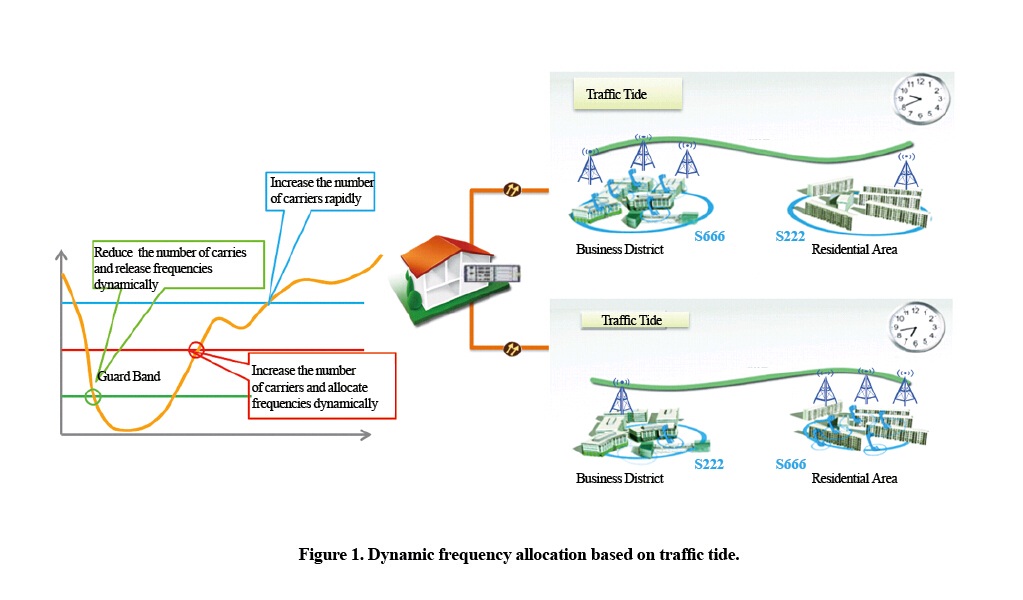
Dynamic GSM frequency sharing is based on the tide of traffic. It is used to dynamically allocate and release carriers according to the carrier on/off status and a measurement of cell traffic. This saves frequency resource, increases spectrum utilization, and reduces interference. Fig. 1 shows two sites with the traffic tidal effect. When traffic is high, each site needs to be configured as S666; when traffic is low, each site is only configured as S222. Traditionally, each site must be configured as S666. Frequencies are dynamically allocated. S666 is configured for a business district during the working hours. At night when traffic lowers to reach the carrier off threshold, the number of carriers is reduced, and frequencies are released. In this case, the S222 configuration is used. In the daytime, when traffic rises to reach the carrier on threshold, a number of carriers are added, frequencies are dynamically allocated, and S666 is configured. The tide of traffic in a residential area moves contrary to that in a business district. Dynamic frequency allocation depends on determining and responding to the tide of traffic. All carriers except BCCH and some high-priority carriers are dynamically allocated and activated according to an interference evaluation. This saves spectrum resources and increases spectrum efficiency without changing system capacity.
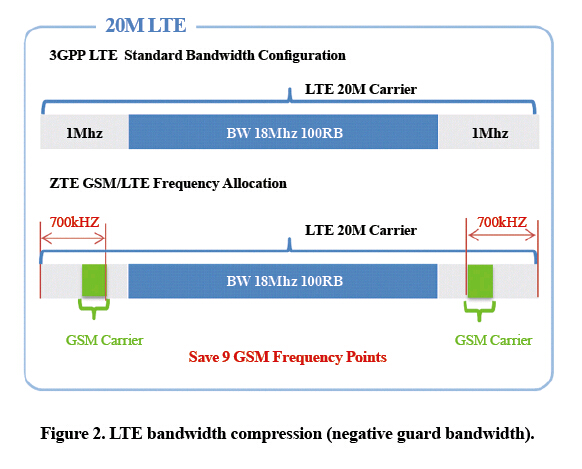
A reasonable guard interval is needed to avoid inter-system interference during GSM/LTE refarming. If the guard interval is too small, more interference is generated in both the GSM and LTE systems. If the guard interval is too large, both GSM system capacity and spectrum efficiency will decreases. A guard interval directly affects interference between different systems or channels and thus affects network coverage, capacity, and user experience. In addition, it is also necessary to consider whether there are sufficient frequency resources reserved for GSM after a guard band has been set and whether the C/I of the GSM network deteriorates seriously after the frequency has been adjusted. It is extremely important to set a reasonable GSM/LTE guard interval. The guard bandwidth for GSM/LTE is generally 200 KHz. An LTE bandwidth has two transition bands. If the LTE bandwidth is 20 MHz, only the 18 MHz band in the middle is used by LTE, and there will be one 1 MHz transition band on the left and right sides (Fig. 2). The signal power near the edge of the 20 MHz band is low. Provided that GSM signals are not affected, GSM frequencies can be configured on the LTE transition bands. ZTE’s Magic Radio solution is designed to leverage the LTE transition bands to implement zero and even negative GSM/LTE guard bandwidth and improve spectrum efficiency using its own innovative filtering algorithm.
GSM/LTE Collaborative Spectrum Scheduling
The GSM/LTE collaborative scheduling solution dynamically schedules spectrum resources occupied by GSM and LTE according to traffic conditions. The solution uses dynamic LTE spectrum spreading and GSM/LTE collaborative scheduling technologies to fully utilize spectrum resources at any time.
Dynamic LTE spectrum spreading involves both bandwidth and carrier spreading. Although GSM and LTE can be deployed in the same frequency band, a guard bandwidth must be reserved. It is complex to release existing GSM spectrum resources according to traffic. In the long term, traffic decreases slowly and progressively, but in the short term, traffic changes along with user behavior and fluctuates dramatically. During working hours, voice traffic is high, and GSM requires high bandwidth. At night, data traffic is high, and LTE requires high bandwidth. The traditional spectrum allocation mechanism cannot allocate spectrum according to traffic demands. This results in wasted spectrum resources.
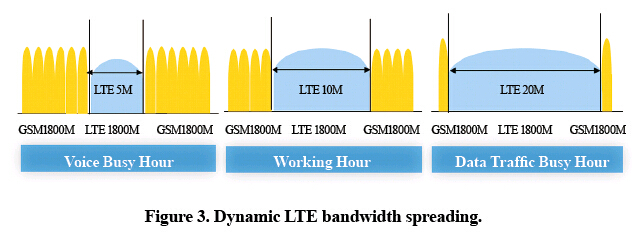
With dynamic LTE spectrum spreading, the spectrum occupied by GSM and LTE can be adjusted according to regional real-time GSM traffic statistics. If GSM traffic decreases, some GSM spectrum resources can be released. When all shared frequencies in the area are released, a specified cell can use these frequencies for LTE. Fig. 3 shows a flexible LTE configuration based on standard or compressed bandwidth. Dynamic LTE carrier spreading is more flexible mode for LTE spectrum spreading. Fig. 4 shows a low-bandwidth dual-carrier LTE configuration based on the standard or compressed bandwidth. The two carriers, with frequencies such as 5 MHz and 1.4 MHz or 5 MHz and 3 MHz, can be aggregated or used as two cells for load sharing. Carrier spreading provides more flexible bandwidth combining and higher spectrum utilization than bandwidth spreading.
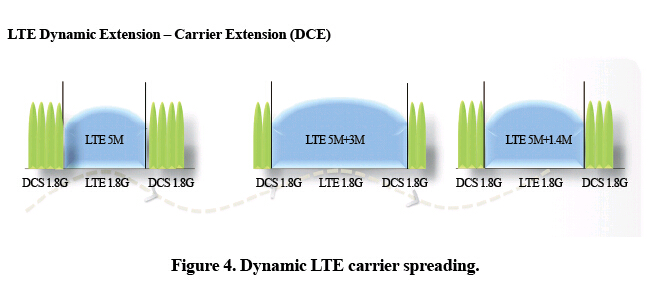
With GSM/LTE collaborative spectrum scheduling, spectrum resources are dynamically scheduled and allocated to GSM and LTE with 200 KHz granularity, as required by traffic. Because the bandwidth configured for LTE can be higher than the available bandwidth, spectrum released when GSM is idle can be used for LTE. The bandwidth occupied by GSM and LTE are automatically adjusted according to their respective traffic loads. When GSM traffic increases, LTE releases some edge resource blocks to GSM; when GSM traffic decreases, the resource blocks at the frequencies close to LTE are released to LTE at first. Compared with dynamic LTE spectrum spreading, GSM/LTE collaborative spectrum scheduling focuses on sharing resource blocks. This provides higher spectrum efficiency. For a 20 MHz LTE bandwidth with 2 MHz transition bandwidth, when GSM traffic increases, GSM/LTE collaborative spectrum scheduling can occupy the LTE operating bandwidth within 18 MHz bandwidth (Fig. 5), and LTE can release some resource blocks to GSM by lowering data rates.
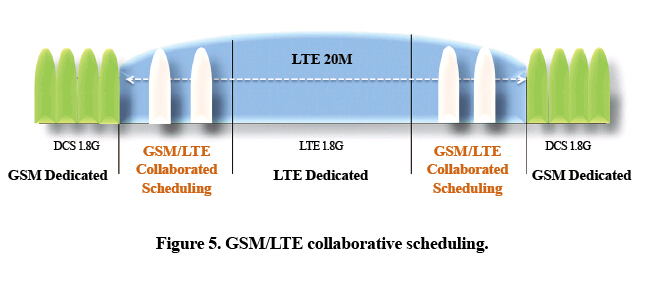
Conclusion
ZTE’s Magic Radio solution focuses on increasing spectrum efficiency during GSM/LTE refarming. The solution has its own innovative proprietary technologies and can deploy GSM and LTE in the same frequency band at the same time. In the future, the solution will be widely used as a preferred key technology for GSM/LTE co-frequency deployment. It will make network deployment easier for operators and also reduce their capex.